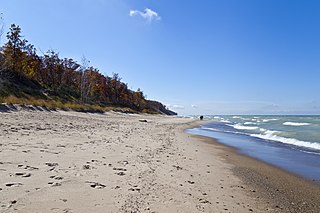 W
WIndiana Dunes National Park is a United States National Park located in Northwestern Indiana, managed by the National Park Service. It was authorized by Congress in 1966 as the Indiana Dunes National Lakeshore, the name by which it was known until it was designated the nation's 61st national park on February 15, 2019. The park runs for nearly 25 miles (40 km) along the southern shore of Lake Michigan; it contains approximately 15,000 acres (6,100 ha). Its visitors center is in Porter, Indiana. Located in the park are sand dune, wetland, prairie, river, and forest ecosystems.
 W
WThe Indiana Dunes comprise ten different habitats. Each provides for a unique combination of plants and animals. The range of the Indiana Dunes varies depending your source. The Indiana Lake Michigan Coastal Program uses the river drainage systems along the shoreline. This expands the area from the areas of lakeshore southward to the edges of the Valparaiso Moraine. This entire region has been dune landscapes since over 114,000 years before present (YBP). Traditionally, the Indiana Dunes area thought of as a narrow area along the shores of Lake Michigan, including the areas of Marquette Park in Gary, Indiana (1920), Indiana Dunes State Park (1926) and Indiana Dunes National Park,. The identified ten habitats can be found in these parks, where they have been preserved, but are also visible throughout the three counties of Northwest Indiana.
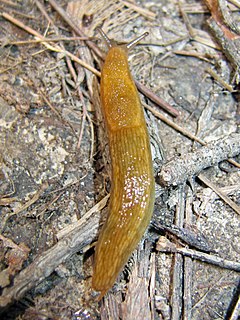 W
WIndiana Dunes National Park is a National Park Service unit on the shore of Lake Michigan in Indiana, United States. A BioBlitz took place there on May 15 and 16, 2009. During that time, a list of organisms was compiled which included invertebrates.
 W
WThis is a list of the non-marine mollusks of the Indiana Dunes. Indiana Dunes National Park is a National Park Service unit on the shore of Lake Michigan in the state of Indiana, United States. A BioBlitz took place there on May 15 and 16, 2009. During that time, a list of organisms was compiled which included land and freshwater mollusks. 46 species of snails and slugs were found, as well as 20 species of freshwater bivalves, freshwater clams and mussels.
 W
WThirty-seven species of mammals have been identified at Indiana Dunes National Park. Four other species are thought to inhabit the park, but have not been documented: the northern long-eared myotis, the Indiana bat, the hoary bat, and the southern bog lemming
 W
WThe Armco-Ferro House, in Beverly Shores, Indiana, was originally constructed for the 1933 Century of Progress Exposition in Chicago. "The ... Exposition opened in May of 1933 directed by the theme of science and its role in industrial advancement. Within the Home and Industrial Arts Group were model houses, which featured modern materials, building methods and innovative home appliances, including the Armco-Ferro-Mayflower, Wieboldt-Rostone and Florida Tropical houses, and the House of Tomorrow. All utilized new techniques of design, construction and prefabrication in an attempt to bring the out-of-date housing industry in line with more efficient manufacturing practices such as those used by the auto industry." The Home and Industrial Arts Group was the most successful venue of the Exposition. The Armco-Ferro House was designed by Robert Smith, Jr., of Cleveland, Ohio. It is the only remaining example from the exposition that met the Fair Committee's design criteria; a house that could be mass-produced and was affordable for an American family of modest means..From research completed by the Historic American Buildings Survey (HABS): The Ferro Enamel Corporation, one of the two major sponsors for the ... house, was formed in 1930 by a merger between the Ferro Enameling Company and the Ferro Enamel and Supply Co. The idea of using porcelain enamel for residential construction was introduced by Bob Weaver, president of the newly formed company. Shortly after the merger, Charles Bacon Rowley, architect, designed a four-person house with Ferro-Enamel shingles that the company erected in Cleveland, Ohio, in July 1932.31 Despite the innovative use of ferroenamel as a cladding material, the house was built using conventional wood construction. The first porcelain-enameled frameless steel house was completed ... in South Euclid, Ohio ... Like the Armco-Ferro house, this house was designed by Robert Smith, Jr., and was built by Insulated Steel Corporation; ... In 1932, the American Rolling Mill Company (Armco) ... built a second porcelainenameled frameless steel house ... using Robert Smith, Jr. as architect. The Ferro Enamel Corporation and the Insulated Steel Construction Company collaborated with Armco, thus setting the stage for the partnership that made the Century of Progress home possible.
 W
WBailly Cemetery is a cemetery located at Indiana Dunes National Park in Porter, Indiana, USA. The cemetery is three-quarters of a mile (1.2 km) north of the Joseph Bailly Homestead on the edge of a sand ridge. The first recorded burial was Robert, the son of Joseph Bailly, in about 1827. Subsequently, the site has been considered a family graveyard. Burials of those outside the Bailly family are numerous. Today, they are all unmarked, including Swedish residents of the area. Outside the cemetery platform to the north there are eight recorded tombstones, four of which are older than 1827: Isaac Schellinger, 1811; Peter Carlbon, 1814; Rhoda Schellinger, 1816; and Thomas B. Speer, 1817.
 W
WChellberg Farm is a historic farmstead which in 1972 became part of Indiana Dunes National Park. Chellberg Farm is significant as it represents the ethnic heritage of a nearly forgotten Swedish-American settlement. The farm includes a family home, water house with windmill, chicken coop/bunkhouse, and the original barn. Other nearby Swedish landmarks have been restored or preserved, including the Burstrom Chapel and the Burstrom Cemetery.
 W
WCowles Bog is a 4,000-year-old wetland complex in Indiana Dunes National Park, near Chesterton, Indiana. It is named for Dr. Henry Chandler Cowles who did his pioneering work in ecology and ecological succession here. His work brought international attention to the area which led to efforts to preserve the Indiana Dunes. It was designated a National Natural Landmark in 1965. It contains bog, fen, marsh, wet meadow, swamp, and pond habitats.
 W
WBoth the Cypress Log Cabin and the Cypress Guest house were sponsored by Southern Cypress Manufacturer's Association, Jacksonville, Florida. The Cypress Cabin was purchased by the Zimmernam Estate represented by Zimmerman, Saxe and MacBride, Chicago architects. It was planned to move the house to St. Joseph, Michigan, where it was to be a summer home near the Bolton exhibit building of the 1893 Columbian Exposition. The move included the Cabin, Guest House and other landscape elements. That move never happened and Robert Bartlett trucked the Cabin and Guest House to Beverly Shores. Bartlett owned the property until 1942, when sold it to Ida J. Osterburg. The house changed owners several times, until it was purchased by the National Park Service in October 1970, becoming part of Indiana Dunes National Lakeshore.
 W
WThe Florida Tropical House is a beach house located on Lake Michigan's shoreline in Beverly Shores, Indiana. The house was originally built in 1933 as part of the Homes of Tomorrow Exhibition during the 1933 World's Fair which took place in nearby Chicago. Today it is part of the Century of Progress Architectural District, a historic district.
 W
WThe Heron Rookery in Porter County, Indiana, was set aside to protect the nesting grounds of the great blue heron. In 1980, the Indiana State Department of Correction transferred 69 acres (28 ha) to the National Park Service in exchange for 33 acres (13 ha) of land at Hoosier Prairie. In 1982, the Youth Conservation Corp constructed the trail and parking at the east side of the unit on County Road 600 E.
 W
WHoosier Prairie began in the 1970s as wasteland that conservation organization found of a unique interest. From a core of 304 acres (123 ha), it has grown to 1,547 acres (626 ha) of important prairie habitat. The area was designated a National Natural Landmark in 1974 and a State Nature Preserve in 1977 The sandy soil creates a variety of habitats, from oak barrens, wet prairie, including sedge meadows and prairie marshes. More than 350 native species of vascular plants have been identified. A minimum of 43 species are uncommon in the State of Indiana. It is a unit of Indiana Dunes National Park.
 W
WThe House of Tomorrow at 241 West Lake Front Drive, Beverly Shores, Indiana, was originally part of Chicago's 1933-34 Century of Progress Exposition. Designed as the house of the future, this house included its own airplane hangar. Glass walls offered views from every angle and so taxed the experimental air conditioning system that the cooling system failed.
 W
WCharles Johnson purchased 6.78 acres (2.74 ha) from a Charles Anderson, who was living in a log cabin on the site since about 1880. When Johnson purchased the property in 1904, that cabin was the only structure, along with an orchard to the southwest of the main house. One of the Johnsons' daughters regularly went to this farm to purchase apples. When Mr. Anderson suggested that he give her the tree, she became adamant that her parents move it. Since that was not possible, Mr. Johnson asked if he could purchase the property, to which Mr. Anderson replied that he would sell, if the Johnsons built him a place back in the woods to live out his life.
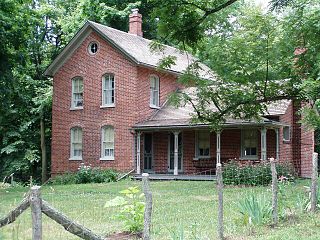 W
WThe Chellberg Farm reflects the ethnic heritage of this nearly forgotten Swedish-American settlement. Other nearby Swedish landmarks have been restored or preserved, including the Burstrom Chapel and the Burstrom Cemetery.[1] The farm includes the family home, water house with windmill, chicken coop/bunkhouse, and the original barn.Farmhouse - Built in 1885, the house is two-story with one-story wing forming a 'L-shaped' structure. It has a gabled roofs on both areas. This is a popular architectural type of late 19th century and can be found in other homes of that time period. The brick is from the Porter brickyards. It was constructed by a local Swedish carpenter. There is a porch on front of 1 story wing. Barn - Built in 1870, the barn is two-stories with partial loft, measuring 50'x24'--approximately 25' to the peak. It is a three-bay floor plan under a wood gable roof. It is built of heavy timbers with a cedar shingle roof, small vent cupola, and wood siding. Chicken Coop - This one-story, single-room structure was built ca 1879. It has a gable roof of wood shingles. It is 10'x24', on a brick foundation. The siding is vertical board and batten. Interior walls have been plastered. Sugar Shack - Built in the 1930s as a utilitarian structure of one-story made from concrete block. The building was built for processing sugar maple sap into maple syrup. The single room is 12'x24' with a gable roof over the concrete floor. Double vertical board doors, standing seam metal gable roof cover the structure. The building has a boiling pan over a brick fire box. This is connected to the brick chimney. The roof includes gabled ridge vent with hopper panel vent, and metal ball finials. A small shed addition was added to east
 W
WThe Pete Larsen Farm is an historic site in Porter County, Indiana.
 W
WThe Lindstrom/Wahl farm is an historic farmstead located to the south of the former community of Baillytown in Porter County, Indiana.
 W
WThis is a list of birds of the Indiana Dunes.
 W
WThe Indiana Dunes is an area of land beside Lake Michigan, in the State of Indiana, United States. It includes Indiana Dunes National Park and Indiana Dunes State Park. This article is about non-native plant species, specifically the invasive species which have colonized that area. Invasive plants are those plants that aggressively spread throughout an area and out-compete other plant species, normally those that are native to the area.
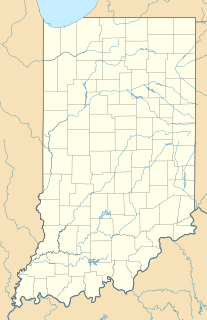 W
WLong Lake is a large interdunal wetland in the Indiana Dunes region of Northwest Indiana. It was originally approximately 8 miles in length, but has been shortened due to development and drainage. It has a surface area of 34 hectares, and a maximum depth of 1.8 meters. There are three small islands, and the total shoreline length is 4.6 kilometers.
 W
WMarquette Park, originally called Lake Front Park, is a municipal park completely surrounded by Indiana Dunes National Park. Its primary elements include 1.4 miles (2.2 km) of white sand Lake Michigan beaches, inland ponds, impressively high sand dunes, wetlands, a lagoon, and indigenous oak savanna. The park is located within the Miller Beach community. Miller Beach was once an independent municipality. However, in 1918 shortly before the establishment of Marquette Park, the Town of Miller was forcibly annexed into the municipal boundaries of Gary, Indiana. The park includes the Octave Chanute museum, registered as a National Landmark of Soaring.
 W
WMiller Woods is the far western unit of Indiana Dunes National Park in the lakefront community of Miller Beach, Indiana. Miller Woods is home to the federally endangered Karner Blue butterfly and the federally threatened Pitcher's thistle. Miller Woods is also the only part of the National Park that also adjoins the Grand Calumet River.
 W
WMount Baldy is a sand dune located in Indiana Dunes National Park. It is on the southern shore of Lake Michigan and is 126 feet tall. It is a wandering dune that moves or shifts every year, and is called a "living dune."
 W
WPetit Fort was a structure located in northwestern Indiana, in or near the Indiana Dunes, near the mouth of Fort Creek, now known as Dunes Creek. It may have been a French military outpost, but was more likely a private residence, trading post, or at most a support station for larger forts in the area. The National Park Service refers to it as a "fur depot."
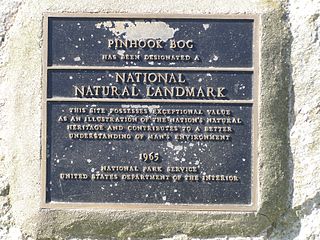 W
WPinhook Bog is a unique bog in Indiana that has been designated a National Natural Landmark. It is part of Indiana Dunes National Park, an area that many citizens, scientists, and politicians fought hard to preserve. Its sister bog, Volo Bog, is located nearby. The bog contains a large variety of plants, including insect eating plants, tamarack trees, stands of blueberry bushes, and floating mats of sphagnum moss. Pinhook Bog is about 580 acres (2.3 km2), a quarter of which is a floating mat of sphagnum peat moss. A "moat" separates the bog from the uplands.
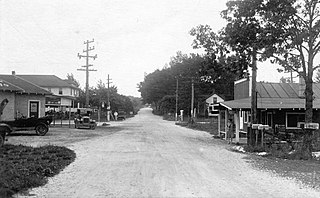 W
WTremont, Indiana, is a ghost town formerly located in what is now the Indiana Dunes State Park and Indiana Dunes National Park in Westchester Township in northern Porter County, Indiana. It was first established in 1833. It was located at the intersection of U.S. Highway 12 and County Road 100 East, near Indiana 49. The community is named for three massive sand dunes that are now contained within the State park. They are Mount Tom, Mount Holden 170 feet (52 m), and Mount Green 160 feet (49 m).
 W
WThe Wieboldt-Rostone House is a house that was built in 1933. Framed in steel and clad with an artificial stone called Rostone. Billed as never needing repairs, it only lasted until the 1950s.
 W
W W
W